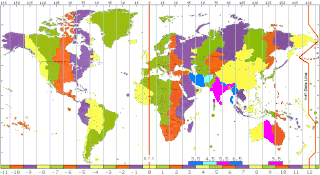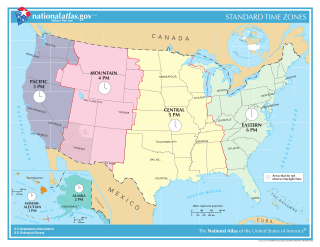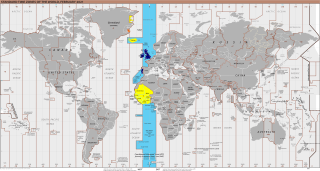Related Research Articles

Greenwich Mean Time (GMT) is the local mean time at the Royal Observatory in Greenwich, London, counted from midnight. At different times in the past, it has been calculated in different ways, including being calculated from noon; as a consequence, it cannot be used to specify a particular time unless a context is given. The term GMT is also used as one of the names for the time zone UTC+00:00 and, in UK law, is the basis for civil time in the United Kingdom.

ISO 8601 is an international standard covering the worldwide exchange and communication of date and time-related data. It is maintained by the International Organization for Standardization (ISO) and was first published in 1988, with updates in 1991, 2000, 2004, and 2019, and an amendment in 2022. The standard provides a well-defined, unambiguous method of representing calendar dates and times in worldwide communications, especially to avoid misinterpreting numeric dates and times when such data is transferred between countries with different conventions for writing numeric dates and times.

A time zone is an area which observes a uniform standard time for legal, commercial and social purposes. Time zones tend to follow the boundaries between countries and their subdivisions instead of strictly following longitude, because it is convenient for areas in frequent communication to keep the same time.
In communications messages, a date-time group (DTG) is a set of characters, usually in a prescribed format, used to express the year, the month, the day of the month, the hour of the day, the minute of the hour, and the time zone, if different from Coordinated Universal Time (UTC). The order in which these elements are presented may vary. The DTG is usually placed in the header of the message. One example is "06:59 Apr 05, 2024 (UTC)"; while another example is "06:59 05 Apr 2024".
Universal Time is a time standard based on Earth's rotation. While originally it was mean solar time at 0° longitude, precise measurements of the Sun are difficult. Therefore, UT1 is computed from a measure of the Earth's angle with respect to the International Celestial Reference Frame (ICRF), called the Earth Rotation Angle. UT1 is the same everywhere on Earth. UT1 is required to follow the relationship

The (International) Radiotelephony Spelling Alphabet, commonly known as the NATO phonetic alphabet, is the most widely used set of clear code words for communicating the letters of the Roman alphabet. Technically a radiotelephonic spelling alphabet, it goes by various names, including NATO spelling alphabet, ICAO phonetic alphabet and ICAO spelling alphabet. The ITU phonetic alphabet and figure code is a rarely used variant that differs in the code words for digits.

The International Meridian Conference was a conference held in October 1884 in Washington, D.C., in the United States, to determine a prime meridian for international use. The conference was held at the request of U.S. President Chester A. Arthur. The subject to discuss was the choice of "a meridian to be employed as a common zero of longitude and standard of time reckoning throughout the world". It resulted in the recommendation of the Greenwich Meridian as the international standard for zero degrees longitude.

The Allied military phonetic spelling alphabets prescribed the words that are used to represent each letter of the alphabet, when spelling other words out loud, letter-by-letter, and how the spelling words should be pronounced for use by the Allies of World War II. They are not a "phonetic alphabet" in the sense in which that term is used in phonetics, i.e. they are not a system for transcribing speech sounds.

The modern 24-hour clock is the convention of timekeeping in which the day runs from midnight to midnight and is divided into 24 hours. This is indicated by the hours passed since midnight, from 00(:00) to 23(:59), with 24(:00) as an option to indicate the end of the day. This system, as opposed to the 12-hour clock, is the most commonly used time notation in the world today, and is used by the international standard ISO 8601.

In the United States, time is divided into nine standard time zones covering the states, territories and other US possessions, with most of the country observing daylight saving time (DST) for approximately the spring, summer, and fall months. The time zone boundaries and DST observance are regulated by the Department of Transportation, but no single map of those existed until the agency announced intentions to make one in September 2022. Official and highly precise timekeeping services (clocks) are provided by two federal agencies: the National Institute of Standards and Technology (NIST) ; and the United States Naval Observatory (USNO). The clocks run by these services are kept synchronized with each other as well as with those of other international timekeeping organizations.

Standard time is the synchronization of clocks within a geographical region to a single time standard, rather than a local mean time standard. Generally, standard time agrees with the local mean time at some meridian that passes through the region, often near the centre of the region. Historically, standard time was established during the 19th century to aid weather forecasting and train travel. Applied globally in the 20th century, the geographical regions became time zones. The standard time in each time zone has come to be defined as an offset from Universal Time. A further offset is applied for part of the year in regions with daylight saving time.

The Newfoundland Time Zone (NT) is a geographic region that keeps time by subtracting 3.5 hours from Coordinated Universal Time (UTC) during standard time, resulting in UTC−03:30; or subtracting 2.5 hours during daylight saving time. The clock time in this zone is based on the mean solar time of the meridian 52 degrees and 30 arcminutes west of the Greenwich Observatory. It is observed solely in the Canadian province of Newfoundland and Labrador. The Newfoundland Time Zone is the only active time zone with a half-hour offset from UTC in the Americas.
Singapore Time (SGT), also known as Singapore Standard Time (SST), is used in Singapore and is 8 hours ahead of Coordinated Universal Time (UTC+08:00). Singapore does not observe daylight saving time.

South African Standard Time (SAST) is the time zone used by all of South Africa as well as Eswatini and Lesotho. The zone is two hours ahead of UTC (UTC+02:00) and is the same as Central Africa Time. Daylight saving time is not observed in either time zone. Solar noon in this time zone occurs at 30° E in SAST, effectively making Pietermaritzburg at the correct solar noon point, with Johannesburg and Pretoria slightly west at 28° E and Durban slightly east at 31° E. Thus, most of South Africa's population experience true solar noon at approximately 12:00 daily.
Time in Chile is divided into three time zones. Most of Continental Chile uses the time offset UTC−04:00 in winter time and UTC−03:00 in summer time, while the Magallanes and Chilean Antarctica region uses the time offset UTC−03:00 the whole year. Additionally, Easter Island uses the time offset UTC−06:00 in winter time and UTC−05:00 in summer time.

UTC+00:00 is an identifier for a time offset from UTC of +00:00. This time zone is the basis of Coordinated Universal Time (UTC) and all other time zones are based on it. In ISO 8601, an example of the associated time would be written as 2069-01-01T12:12:34+00:00. It is also known by the following geographical or historical names:
Nautical time is a maritime time standard established in the 1920s to allow ships on high seas to coordinate their local time with other ships, consistent with a long nautical tradition of accurate celestial navigation. Nautical time divides the globe into 24 nautical time zones with hourly clock offsets, spaced at 15 degrees by longitudinal coordinate, with no political deviation.

Coordinated Universal Time or UTC is the primary time standard globally used to regulate clocks and time. It establishes a reference for the current time, forming the basis for civil time and time zones. UTC facilitates international communication, navigation, scientific research, and commerce.

Time in Liberia is given by a single time zone, denoted as Greenwich Mean Time. Liberia shares this time zone with several other countries, including fourteen in western Africa where it was formerly known as Western Sahara Standard Time (WSST). Liberia has never observed daylight saving time (DST).
Nigeria observes West Africa Time (WAT), which is one hour ahead of Coordinated Universal Time (UTC+01:00), year-round as standard time. Nigeria has never observed daylight saving time. It shares WAT with fourteen other countries in Africa. Nigeria's local mean time was UTC+00:13:35.
References
- 1 2 3 4 Combined Communications-Electronics Board (Oct 2010). ACP 121(I), COMMUNICATION INSTRUCTIONS – GENERAL (PDF) (Report). pp. 3A-1–3A-8. Archived from the original (PDF) on May 8, 2016. Retrieved Aug 8, 2011.
- ↑ "ATP 6-02.70 Techniques for Spectrum Management Operations" (PDF). Retrieved 2020-07-21.
- ↑ "Plans and Orders: Expressing Time", Army Planning and Orders Production, Field Manual 5-0 (FM 101-5) (PDF), Headquarters Department of the Army, United States Army, 20 January 2005, p. G11,
Express all times in a plan or order in terms of one time zone, for example ZULU (Z) or LOCAL (L). I
- ↑ FM 5-0: Planning and Orders Production. Headquarters, Department of the Army. May 2022. pp. D-6.
{{cite book}}: CS1 maint: date and year (link) - ↑ Morris, Doug (May 2008). "Time for the Weather: Translating Zulu". Weatherwise. 61 (3): 32–35. doi:10.3200/WEWI.61.3.32-35. S2CID 194035906.
- ↑ Leigh, Gabriel (17 November 2020). "Zulu and UTC: the story behind aviation's time zone". Flightradar24 Blog.
- ↑ "Military Time Zones". Veteran.com. 31 October 2022.
- ↑ Stromberg, Joseph (November 18, 2011). "Sandford Fleming Sets the World's Clock". Smithsonian Magazine.
To this day, if you look at certain [military] maps that divide the world into time zones, the zones are assigned letters,
- ↑ Principal Staff Officers Committee (1950-06-15). SG 037: Method of expressing date and time in military messages (Report). NATO Archives Online.
- ↑ "Time Zones for Earhart Radio Message Database" (PDF). Finding Amelia Resource Library. Retrieved 2 June 2023.
- ↑ "Standard for the format of ARPA network text messages". Internet Engineering Task Force. November 1977.
- ↑ Braden, Robert T. (October 1989). "Requirements for Internet Hosts - Application and Support". Internet Engineering Task Force.
- ↑ Resnick, Pete (1 April 2001). "Internet Message Format". Internet Engineering Task Force.